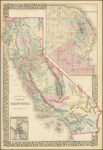When the Chinese boy is taken from her and given to the Chinese woman, who claims to be the mother, Ruth Anne spirals into suicidal depression. A smart and ingenious boy, he finds a way to escape back to his home with Caleb and Ruth Anne. His return is only temporary as the sheriff returns and takes the Chinese boy back to Sacramento to live with the Chinese woman. Ruth Anne travels to Sacramento and works with an old acquaintance to secrete the boy onto a train to San Francisco and a safe environment.











